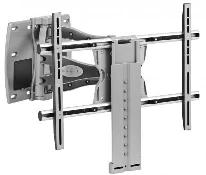
If you're looking for a large TV but you're wondering whether you home has the space for it, then mounting your TV on a wall could be an option. TV mounts are effective in maximising space around your home while also giving your television setup a sleek, carefully designed look.
Why mount your TV?
One of the main reasons people chooose to mount their TVs is space - or rather a lack of it. There are many different ways for a television to be mounted off the ground, either statically or in a way that gives you fine control over the angle and direction in which your TV faces.
The 'VESA mount' is the mounting system normally used to mount TVs or other displays on walls or stands. VESA (which stands for 'Video Electronics Standards Association') is an industry body of manufacturers, set up to create and agree on certain standards to do with television and display systems. The VESA mount is more correctly (but less commonly) referred to as the VESA Mounting Interface Standard (MIS) or the Flat Display Mounting Interface (FDMI).
Because it's been developed and promoted by a collective body of different manufacturers, the same mount will fit most televisions of a particular size, regardless of the brand. The VESA mount ensures that all screw hole patterns, cable exits and mount depths are identical on all compatible TVs and mounts, meaning that provided you know which mount type to get, putting your TV on the wall or a stand is a fairly predictable process.
Some products are even available for you to mount your TV straight onto plasterboard without it breaking. Regardless of this, it's always a good idea to have your mount installed and your TV mounted by a qualified installer, who will ensure the safety of your TV when it is mounted off ground. Watching a $3000 TV smash onto the floor is a gut wrenching experience!
Which mount size do I need?
First and foremost, you should consult your TV's manual or call the manufacturer to ensure that your TV does support a standard VESA mount, and to find out exactly which type is suitable.
There are four main types of VESA mounts, which differ in terms of the screw types they require and the different distances theyt allow between the screws horizontally and vertically. Larger TVs will obviously require stronger mountings and bigger screws. Below is a table outlining the names of the different mounting types, and the configurations they support:
| VESA mount plate type | Screw distances (H x V) | Screw type |
|---|---|---|
| MIS-D 75 | 75mm x 75mm | M4 |
| MIS-D 100 | 100mm x 100mm | M4 |
| MIS-E | 200mm x 100mm | M4 |
| MIS-F | 200mm x 200mm | M6, M8 |
| 400mm x 400mm | ||
| 600mm x 200mm | ||
| 600mm x 400mm | ||
| 800mm x 400mm | ||
| 280mm x 150mm |
Types of wall mounts
Wall mounts are probably the most popular mount types for homes and come in many varieties. There are various different types of wall mounts available, allowing different degrees of adjustment to be made to the way your TV is displayed:
- Flat - A flat wall mount fixes the TV to a certain point on the wall, from which it is unable to move.
- Tilting - A tilting wall mount allows you to control the vertical movement of your TV.
- Full-motion - A full-motion wall mount allows your TV complete movement both vertically and horizontally.
Other types of mounts
Mounting your TV to a wall mightn't always be the convenient or safe option. For these circumstances, other types of mounts are available, including pole and ceiling mounts.
Although some come with their own counterweight, most pole mounts will still be fastened to the ground in some way. Pole mounts do offer some unique advantages over wall mounts in that they may allow you to place a TV in the middle of a room, or high up in a corner.
Ceiling mounts refer to those TVs that can be hidden in your roof cavity, and revealed as and when they're needed by remote control. An electric motor lowers the screen down when you want to use it, and lifts it back up to conceal it when you're finished. Ceiling mounts are also useful if you don't have any wall or floor space to spare.
Before deciding on any type of mount you should always check with your qualified installer as to what option will be best for you and your home.